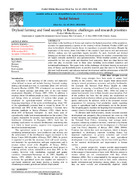| dc.description.abstract | Agriculture is the backbone of Kenya and employs the highest proportion of the population, accounts for approximately a quarter of the country’s Gross Domestic Product (GDP) and close to two-thirds of total exports, hence its importance in poverty alleviation. Despite the importance of the sector, about four-fifths of the country’s land area is arid and semi-arid (ASAL), making rain fed agriculture largely enviable. As such, livestock and dry land farming are elevated to the highest among livelihood options for resident communities who are largely nomadic pastoralism and agro-pastoralists. While weather patterns are largely responsible for low crop yields and therefore food insecurity, there are other factors that come into play to escalate want in these areas including socio-cultural dynamics and institutional bottlenecks. This paper looks at the challenges of dryland farming in semi-arid areas of Kenya and henceforth points at possible research gaps that need to be bridged to alleviate food insecurity and enhance national development and the achievement of the UN Millennium Development Goal 1 of eradicating extreme poverty and hunger | en_US |
